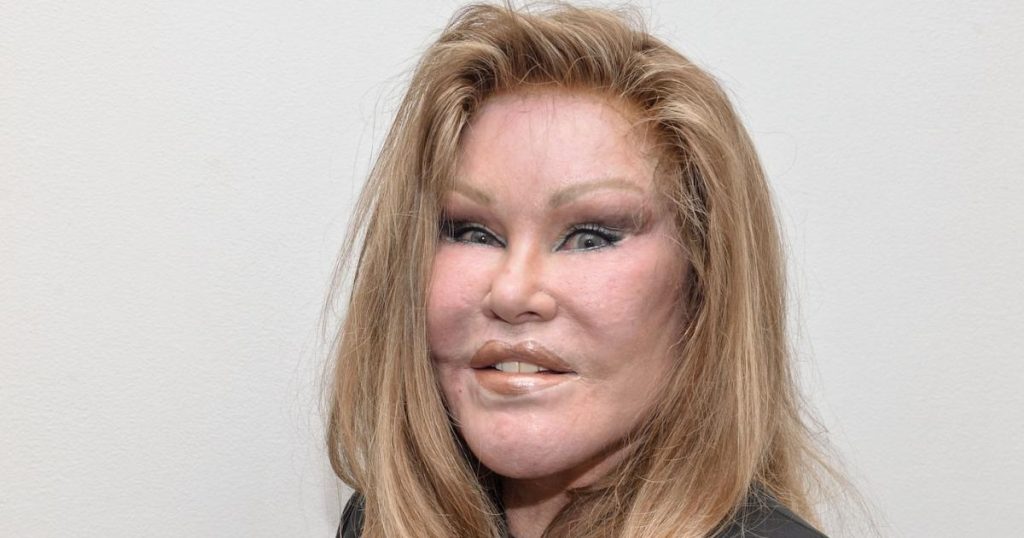Jocelyn Wildenstein, a name synonymous with extravagant lifestyle, high-profile relationships, and dramatic cosmetic procedures, passed away at the age of 84 on December 31, 2023, in Paris. Her death, attributed to a pulmonary embolism, marked the end of a life lived under the intense scrutiny of the public eye. While she was often recognized for her altered appearance, which earned her the moniker “Catwoman,” Wildenstein’s life was a complex tapestry woven with threads of privilege, controversy, and a relentless pursuit of self-transformation. Beyond the headlines and sensationalized images, a closer look reveals a woman navigating the complexities of wealth, love, and the pressures of societal expectations. Even in her final year, Wildenstein remained engaged in projects aimed at shaping her public image and securing her legacy, as evidenced by the unrevealed reality television show she filmed prior to her death.
The news of Wildenstein’s passing was confirmed by her long-time partner, Lloyd Klein, who described her as an “icon” and expressed his profound grief. Klein, a fashion designer, was also involved in the reality show project Wildenstein filmed before her death. The show, which followed the couple’s move from Miami to Los Angeles and Klein’s efforts to revitalize his fashion brand, Lloyd Klein Couture, offers a glimpse into their lives beyond the tabloid narratives. It represents an attempt by Wildenstein to control her own narrative and present a more multifaceted portrait of herself to the world. While the show remains unreleased, its existence underscores Wildenstein’s continued desire to remain in the public eye and shape her own image.
Wildenstein’s transformation, both physical and social, began with her marriage to billionaire art dealer Alec Wildenstein in 1978. This union catapulted her into the world of extreme wealth and social prominence. However, it was also during this time that her physical appearance began to undergo dramatic changes through a series of cosmetic procedures. While the extent to which these procedures were driven by her own desires or influenced by her husband remains a subject of speculation and conflicting accounts, they undeniably became a defining aspect of her public persona. The “Catwoman” moniker, while initially perhaps a playful reference to her affinity for feline features, became a label that both intrigued and repelled, solidifying her image as a woman obsessed with altering her appearance.
The Wildensteins’ divorce in 1999, after a tumultuous and highly publicized legal battle, further fueled public fascination with Jocelyn. The divorce proceedings exposed the couple’s extravagant lifestyle and the deep-seated tensions within their marriage. Alec Wildenstein, in interviews given at the time, claimed he had no influence over his wife’s surgical choices, suggesting she acted independently and compulsively. Jocelyn, however, countered these claims, alleging that Alec had orchestrated a smear campaign to discredit her during the divorce proceedings. These conflicting narratives only served to intensify public interest and further solidify Wildenstein’s image as a figure of both fascination and ridicule.
Jocelyn Wildenstein’s legacy remains complex and multifaceted. She was undoubtedly a product of her time, a period marked by increasing societal acceptance of cosmetic procedures and the rise of reality television. She embraced these trends, perhaps even becoming a symbol of them, albeit a controversial one. While her choices were often met with criticism and mockery, they also reflected a desire for self-expression and a refusal to conform to conventional beauty standards. Whether one views her as a victim of societal pressures or as an individual exercising her autonomy, her story remains a compelling example of the complexities of identity and the human desire for transformation in the age of media saturation.
Beyond the headlines and the “Catwoman” persona, Jocelyn Wildenstein was a mother of two, Alec Jr. and Diane, from her marriage to Alec Wildenstein. Her children represent a more private aspect of her life, largely shielded from the relentless glare of the media spotlight. While the public may never fully understand the woman behind the mask, her story serves as a cautionary tale about the potential pitfalls of fame, wealth, and the relentless pursuit of an ever-elusive ideal of beauty. Her life, lived under the constant gaze of the public eye, serves as a reminder of the human cost of living a life perpetually transformed into a spectacle.

